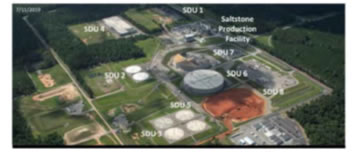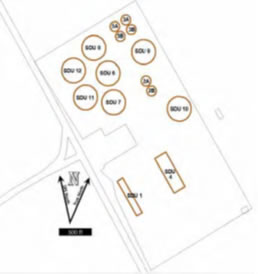NDAA Section 3116 Waste Incidental to Reprocessing (WIR) at the Savannah River Site (SRS) in South Carolina – Saltstone Disposal Facility (SDF)
SRS SDF in Aiken, South Carolina
| Operator: U.S. Department of Energy |
Under Section 3116(b) of the Ronald W. Reagan National Defense Authorization Act for Fiscal Year 2005 (NDAA), the U.S. Nuclear Regulatory Commission (NRC), in coordination with the NDAA-Covered State monitors the U.S. Department of Energy (DOE) disposal actions to assess compliance with the NRC regulations in Title 10 of the Code of Federal Regulations (10 CFR) Part 61, "Licensing Requirements for Land Disposal of Radioactive Waste," Subpart C, "Performance Objectives." The NDAA-Covered States are currently Idaho (ID) and South Carolina (SC).
The Savanah River Site (SRS) is a 802 square kilometer (km2) (310 square mile (mi2)) facility located in south-central SC, which began operation in 1951 producing nuclear materials for national defense, research, medical, and space programs. Waste produced at the site from spent nuclear fuel reprocessing for defense purposes has been commingled with non-reprocessing waste resulting from the production of targets for nuclear weapons and production of material for space missions. Significant quantities of radioactive waste are currently stored onsite in large underground waste storage tanks, which were placed in operation between 1954 and 1986. The waste stored in the tanks is a mixture of insoluble metal hyrdroxide solids, referred to as sludge, and soluble salt supernate. The supernate volume has been reduced by evaporation, which also concentrates the soluble salts to their solubility limits. The resultant solution crystallizes as salts and the resulting solid is referred to as saltcake. The saltcake and supernate combined are referred to as salt waste.
The DOE removes the salt waste, treats it to remove highly radioactive radionuclides to the maximum extent practical, and disposes of the low activity fraction onsite in the SDF. The Saltstone Disposal Facility (SDF) is located in the SRS Z-Area, which is approximately 10 kilometers (6.2 miles) from the nearest SRS site boundary on a local topographic high. In the future, after all the disposal structures are operationally full, the DOE will put two covers over the SDF.
Currently, the DOE constructed and put into operation disposal structures:
- two rectangular: Saltstone Disposal Structure (SDS) 1 and SDS 4
- six smaller round: SDS 2A, SDS 2B, SDS 3A, SDS 3B, SDS 5A, and SDS 5B
- four larger round: SDS 6, SDS 7, SDS 8, and SDS 9
Currently, the DOE plans to construct and put into operation the future disposal structures:
- three larger round: SDS 10, SDS 11, and SDS 12
Major NDAA WIR Consultation & Monitoring Documents For The SRS SDF:
Document | Date | ADAMS Accession No. |
|---|---|---|
NDAA Section 3116(a) Consultation Documents | ||
DOE Draft Basis for Waste Determination | 02/28/2005 | |
NRC Technical Evaluation Report | 12/28/2005 | |
DOE Final Basis for Waste Determination | 01/17/2006 | |
DOE Waste Determination by Sec. of Energy | 01/17/2006 | |
NDAA Section 3116(b) Monitoring Documents | ||
NRC Monitoring Plan | 05/03/2007 | |
NRC Onsite Observation Visit Report | 01/31/2008 | |
NRC Onsite Observation Visit Report | 06/05/2008 | |
NRC Onsite Observation Visit Report | 09/24/2008 | |
NRC Onsite Observation Visit Report | 04/22/2009 | |
NRC Technical Review Report | 08/25/2009 | |
NRC Technical Review Report | 09/01/2009 | |
NRC Technical Review Report | 09/01/2009 | |
NRC Onsite Observation Visit Report | 09/30/2009 | |
NRC Onsite Observation Visit Report | 10/01/2009 | |
NRC Technical Review Report | 10/23/2009 | |
DOE 2009 Performance Assessment | 10/31/2009 | |
NRC Technical Review Report | 11/09/2009 | |
NRC Technical Review Report | 11/12/2009 | |
NRC Onsite Observation Visit Report | 06/07/2010 | |
NRC Onsite Observation Visit Report | 07/07/2010 | |
NRC Onsite Observation Visit Report | 11/19/2010 | |
NRC Onsite Observation Visit Report | 03/15/2011 | |
NRC Onsite Observation Visit Report | 08/09/2011 | |
NRC Technical Evaluation Report, Rev. 1 | 04/30/2012 | |
NRC Type-IV Letter of Concern | 04/30/2012 | |
DOE Response to NRC Type-IV Letter | 07/12/2012 | |
DOE Additional Response to NRC Type-IV Letter | 07/26/2012 | |
NRC Acknowledgement of DOE 07/12/2012 Letter | 08/31/2012 | |
NRC Onsite Observation Visit Report | 11/19/2012 | |
NRC Onsite Observation Visit Report | 02/15/2013 | |
NRC Onsite Observation Visit Report | 08/23/2013 | |
NRC Monitoring Plan, Rev. 1 | 09/01/2013 | |
NRC Technical Review Report | 11/07/2013 | |
NRC Onsite Observation Visit Report | 08/28/2014 | |
NRC Onsite Observation Visit Report | 05/27/2015 | |
NRC Technical Review Report | 06/04/2015 | |
NRC Onsite Observation Visit Report | 09/28/2015 | |
NRC Onsite Observation Visit Report | 07/15/2016 | |
NRC Technical Review Report | 08/01/2016 | |
NRC Technical Review Report | 12/23/2016 | |
NRC Technical Review Report | 01/05/2017 | |
NRC Technical Review Report | 03/23/2017 | |
NRC Technical Review Report | 04/12/2017 | |
NRC Onsite Observation Visit Report | 05/05/2017 | |
NRC Letter Supplementing the Monitoring Plan | 06/05/2017 | |
NRC Technical Review Report | 01/31/2018 | |
NRC Letter Supplementing the Monitoring Plan | 03/01/2018 | |
NRC Technical Review Report | 05/17/2018 | |
NRC Technical Review Report | 05/22/2018 | |
NRC Letter Supplementing the Monitoring Plan | 06/29/2018 | |
NRC Technical Review Report | 06/29/2018 | |
NRC Letter Supplementing the Monitoring Plan | 10/16/2018 | |
NRC/DOE Joint Plan to Resolve the NRC Type-IV Letter of Concern | 10/23/2018 | |
NRC Onsite Observation Visit Report | 11/01/2018 | |
NRC Technical Review Report | 05/28/2019 | |
NRC Letter Supplementing the Monitoring Plan | 08/05/2019 | |
NRC Onsite Observation Visit Report | 11/27/2019 | |
DOE 2020 Performance Assessment | 03/02/2020 | |
NRC Onsite Observation Visit Report | 09/28/2021 | |
NRC Letter Supplementing the Monitoring Plan | 10/18/2021 | |
NRC Onsite Observation Visit Report | 03/28/2023 | |
ADAMS Package for 10 Technical Review Reports Supporting Technical Evaluation Report, Rev. 2 | 04/18/2023 | |
NRC Technical Evaluation Report, Rev. 2 | 04/20/2023 | |
NRC Onsite Observation Visit Report | 10/29/2024 | |
NRC Monitoring Plan, Rev. 2 | 05/31/2025 | |
Current Status Of NDAA Section 3116(b) Monitoring For The SRS SDF:
ITEM | STATUS |
|---|---|
NRC Conclusion from Current 2023 Technical Evaluation Report | The NRC conducted its independent, risk-informed, performance-based technical review pursuant to the NDAA. The NRC reviewed the 2020 DOE SDF PA and its supporting documents, including documents provided by the DOE after the DOE Submittal. Based on the information in this TER, if the DOE Closure Cap design and implementation achieve the DOE expected performance as described in the 2020 SDF PA, then the NRC concludes that it has reasonable assurance that the DOE disposal actions at the SDF meet or will meet all the 10 CFR Part 61 POs, including the §61.40 PO. |
NRC Notification Letters – based on NRC review documented in 2023 Technical Review Report | None |
NRC Open Issues – based on NRC review documented in 2023 Technical Evaluation Report | None |
NRC Monitoring Areas (MAs) and Monitoring Factors (MFs) in Monitoring Plan, Rev. 2, as supplemented by later NRC letters, which was result of NRC review documented in 2023 Technical Evaluation Report | All 11 MAs are Open, 5 MFs are Closed (MF 3.01, MF 3.02, MF 3.04, MF 5.05, & MF 6.02), and the other 37 MFs are Open |
Current NRC Project Manager: Harry Felsher, 301-415-6559, Harry.Felsher@nrc.gov
Page Last Reviewed/Updated Monday, September 29, 2025
Page Last Reviewed/Updated Monday, September 29, 2025



